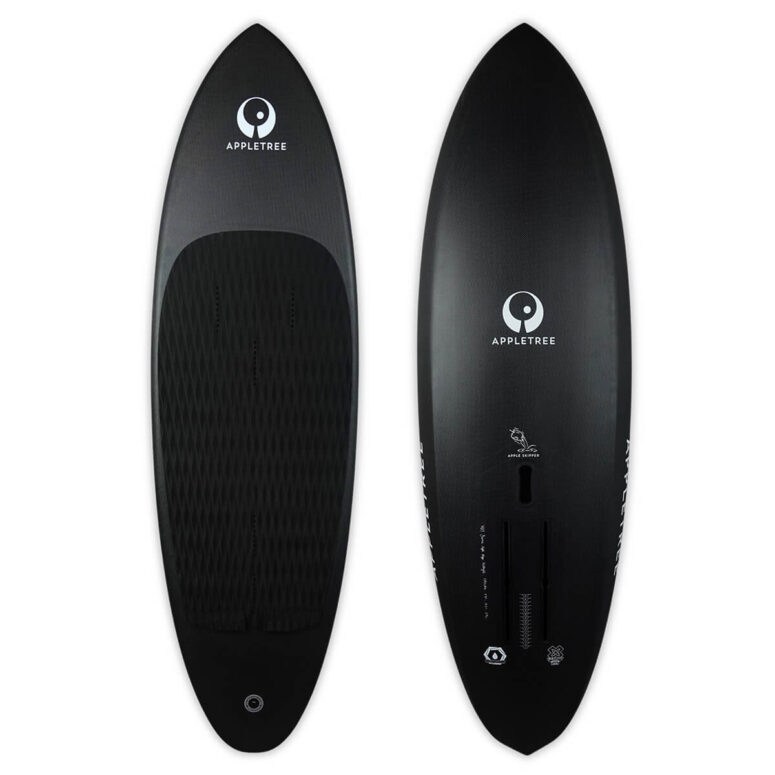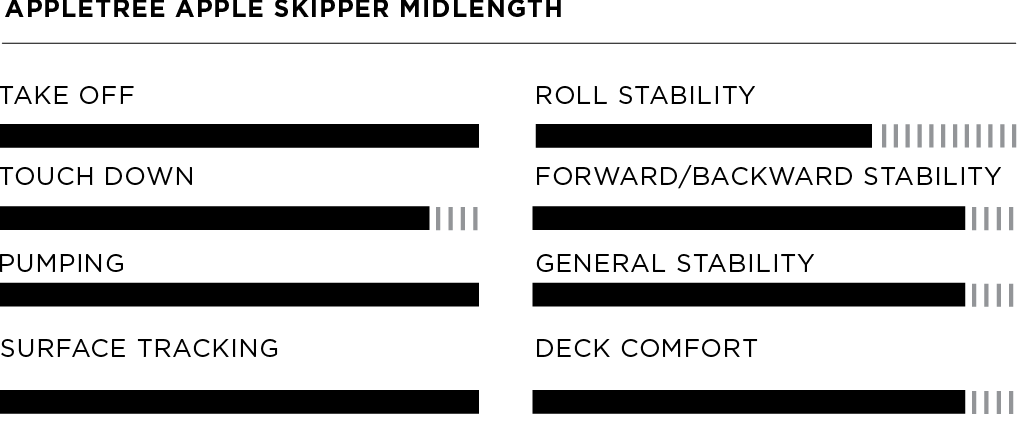

When you purchase gear through links on our site, we may earn a small commission. Here’s why you can trust our tests and our affiliate partner.

With their own factory in Portugal, Appletree can be agile when it comes to responding to market trends. Mid-length fever hit us last year, and whilst the Appleslice V3 was certainly 80% of the way, a more extreme and slender shape was already in development. Balancing a mid-length’s attributes to make it as versatile as possible is a challenge, and we’ve seen some brands perhaps bias one discipline more than others, but Appletree’s massive size range caters for everyone, with seven sizes from 37l to 97l in 10 liter increments. Customs are of course available in terms of both color and sizing. Lengths range from 5’0” to 6’8” in the bigger sizes. Our test board was an 87l 6’4 which has been perfect for lightwind frolicking in the UK.
Due to the explosion in demand for Foil Drive boards, the Zapple was released earlier than the Skipper Midlength, but logically you will see a very similar board without the trench. Design wise, we’ve got a slender shape with some extra length per volume. Sharp lower rails and long clean lines maximize its planing area, with a forward foil box position and elongated track box. Its design influence is drawn from other displacement hull sports – think kayak and canoes or performance SUPs – this means it’s as efficient as possible through the water. These attributes combine to make a board that planes, builds speed and activates the foil extremely quickly, meaning less action and less flapping. There’s a little kick of tail rocker which definitely helps release. Y-oriented strap inserts are present to keep the masses happy, but on this style of board I find myself changing my stance regularly to maximize efficiency in different situations, but for those that like the feeling of assurance or want to jump, they are there if required.
Build is to the usual extremely high standard with closed-cell waterproof foam and a vacuum-infusion technique employed. This year they’ve beefed up the noses and decks of the board even further to help avoid elbow dents or if you manage to smash your boom into it. This also stiffens what was already a very rigid board and translates the foil feeling more, which we assumed wouldn’t be possible.
For winging, rather than a pure lightwind choice, think of it as a lower wind-range extender, or smaller or more performance foil enabler. What we weren’t expecting was how well the board continues to ride in higher windspeeds; because it’s narrow, it pierces the wind well. Its narrowness and rocker in the tail means, although a longer board, it doesn’t seem to catch as much as we’d expect.
For foil assist, the Zapple genetics make it an absolute winner, so if you’re not quite committed enough to get a trench board, this is without a doubt the board from the range to choose for assisted prone. Our signal tests came back very positive with no need for running an antennae.
In the pursuit of parawing, the Midlength was great for more powered sessions stepping down from full flotation, where an early as possible release is extremely important. It made for easier cornering and better angles upwind, due to the reduction in drag from the bigger board. With the more positive pull of a K-Wing it works extremely well and made the wave-riding experience far more playful.
For a non-committal prone rider like myself, the Midlength in a generous volume was quite a revelation. It paddles quick and the rocker fits well into smaller waves for extremely easy takeoffs. Pumping it was where it really shone, as it’s so stiff for a big board; very little energy is lost and we could wobble off for as long as our lung capacity could handle.
Winging the 87l Midlength alongside the 80l Appleslice V3 was an interesting experiment. The Slice has a little more roll stability due to its width so is less of a handful on the surface, but the Midlength definitely takes off significantly earlier, enabling you to be on a smaller foil or use less wind in equivalent volumes. If you’re a more novice rider in choppy conditions take the Slice all day long, but a more advanced rider could easily take a Midlength into more consequential conditions and rougher sea states, and benefit from the improved low-end to get them on a smaller foil.
The mid-length sector is now burgeoning with options from many manufacturers; what sets the Appletree Apple Skipper apart for the consumer is the stiff build, the highly efficient release, and the massive range of sensible dimensions. It’s also stiff, very stiff in fact, and for a larger board doesn’t feel cumbersome as a result. Mix into that the higher sustainability credentials and longevity of the product and it’s a benchmark in cross-discipline versatility. Size it right and the Midlength is a travel board you can take into a plethora of situations.
